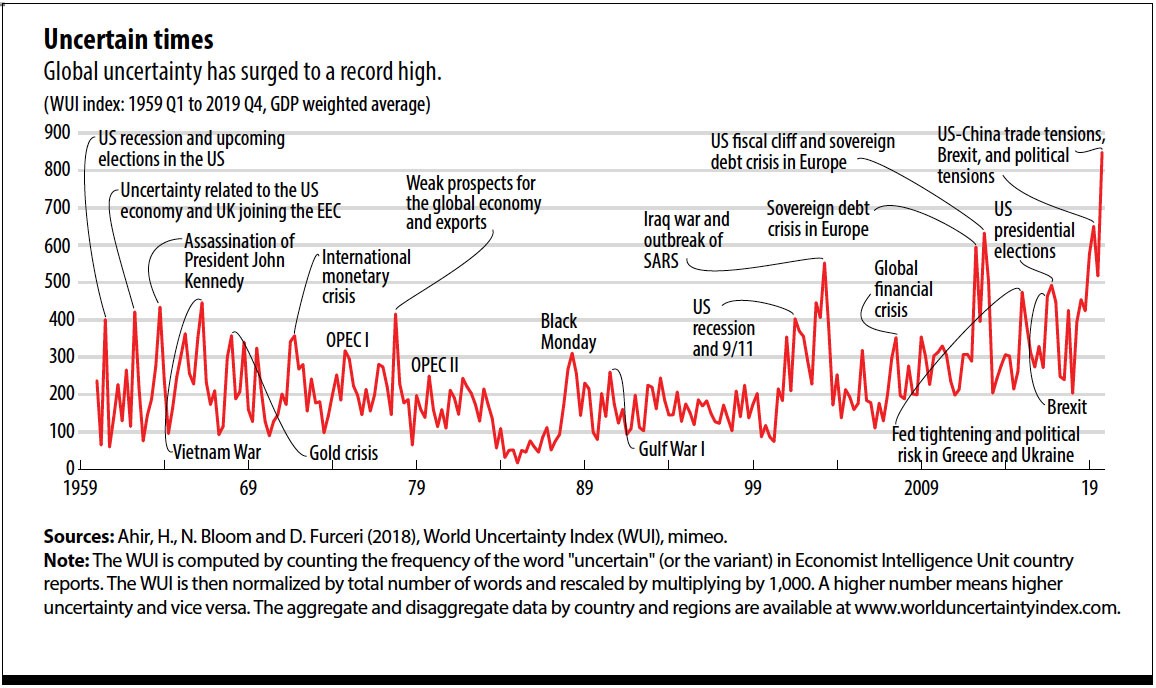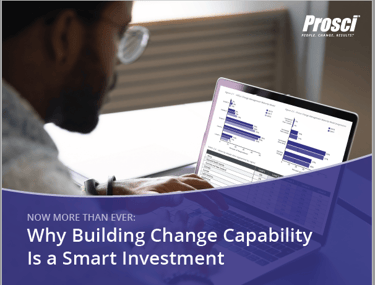For those of us who study change, the events of the last year have served to validate our belief that volatility, uncertainty, and complexity are normal, that the pace change is increasing, and organisations who are responsive to change and even thrive from it hold a sustainable competitive advantage. Unfortunately, for many companies who were already challenged by this environment, they are now facing a do or die situation.
As Prosci® research done prior to 2020 indicated, 86% of senior leaders believed that the amount of change they were expecting in their business was increasing (I suspect that the dissenting 14% would now agree with them). What has become clear since that survey was released is that they were not only right, the participants probably had no idea how right they were. It may be hard to imagine but even without Covid-19, the global business environment was already pretty volatile. We have recently experienced upheavals in oil markets, growing trade restrictions as well as unrest in the Middle East, Asia and Latin America, growing nationalism, disruptions in supply chains and much more.
All of this volatility creates uncertainty in the markets, and uncertainty is growing. According to the International Monetary Fund, the World Uncertainty Index was already surging before pre-Covid. They stated,
“The latest data for the fourth quarter of 2019 show that, after dipping in the third quarter of 2019, the aggregate index - a GDP-weighted average of 143 countries -is at an all-time high.”

We can only expect that it is even higher now.
While we are not uncertainty analysts and cannot make predictive statement on the impact to specific businesses or industries, our purpose is to help organisations prepare for change. That change is coming faster and faster and that is harder and harder to predict, only make preparation more and more important.
The challenge is getting leaders to understand that preparing for rapid change in uncertain and complex environments requires them to change as well. Leaders often make the mistake that they are working to build organisations that are robust or resilient to change, and that are able to withstand change or absorb it, Really, they should be thinking about how to build organisations that are able to thrive as a result of volatility and rapid change.
“This is the central illusion in life: that randomness is a risk, that it is a bad thing… Much of modern life is preventable chronic stress injury…The fragile wants tranquillity, the anti-fragile grows from disorder, and the robust doesn't care too much.”
- Nassim Nicholas Taleeb, Author of Antifragile: Things that Gain from Disorder
Yet, embracing uncertainty and preparing for rapid change is not easy. One key reason is that managers have not been trained to think this way. Whenever I discuss these concepts with managers, inevitably they acknowledge the problem then immediately start boasting about how they are building robust processes to reduce complexity, eliminate unpredictability, and withstand change while working to gain greater control over their business through centralisation or some other means.
This attitude is not unexpected. Change and uncertainty tend to trigger the survival instincts in us all, causing us to revert to the behaviours we have been rewarded for throughout our lives and careers. Typically, this means attempting to collect data, manage outcomes, and ultimately show that we are in control. This may be an adequate approach in a simple organisation with singular objectives and little change, but as uncertainty and complexity build, as the environment has more impact on our business, and variables come into play; this command and control approach proves inadequate, expensive, and potentially fatal resulting in in action and stagnation.
Download: Why Building Enterprise Change Capability is a Smart Investment
While there has been a lot written on these topics in the last fifteen years, it is difficult to convince leaders that what they have learned is actually working against them. This is because at the core of their behaviour lies principles that have been hammered into their consciousness for more than a century- principles encompassed in Frederick Taylor’ Scientific Management and embedded in the structures of most organisations today. These principles such as hierarchical structures, separating thinkers and doers, process optimisation developed during the industrial revolution, served companies well during the days of mass production. But this success is also the challenge for many organisations today who are living in much different times. Rather, in today’s environment where complexity, inter-connectedness, and mass information make our world less certain and predictable, it makes sense to build agility, responsiveness, and flexibility into our organisations.
There is nothing new in this thinking as these have become the buzz words of the last decade. However, it is easy to say and harder to do. Moreover, how we think about and apply change management has often remained in the traditional world focusing on project level change, waterfall methods, and hierarchical approaches. So as business evolves to deal with unpredictability so must our approach to dealing with change.
But where to begin? That is always a key question. Here are eight ways to get started.
- Look at yourself: Embracing uncertainty is a change in mindset that requires leaders specially to relinquish control and enable change to emerge. Once they can do this, they can begin to strategise for change. However, this is not something that comes naturally for many people. It must be learned.
- Ensure a clear purpose and vision: When things become chaotic and uncertain, having a clear course to steer by becomes invaluable. Your organisations purpose and vision provide that course. The more people are aware and understand the “why” the change, the better and faster they can respond.
- Assume that change is inevitable and continuous: Too often leaders and organisations see change as a one-time effort, something we have to get through and get over. They expel a lot of energy hoping to get back to their “new normal.” This approach invites lethargy. By assuming change will continue, organisations can build their endurance so that each change takes less energy out of the organisation.
- Structure for change: Building a change capability throughout organisation that will enable it to respond faster and better. There is no one right answer to the structure. It can depend on many elements (culture, complexity, history, etc). But by creating a systematic approach, framework, and language into your organisation and making sure everyone had the knowledge and ability to apply them, can help ensure the organisation is prepared for the inevitable. In Prosci® this is part of an Enterprise Change Management strategy.
- Build competency for change: Create a strategy to raise the competency and thus maturity for change in your organisation. This involves looking at the entire organisation, determining who needs what level of competency, and equipping them. While developing practitioner coaches is a good start, including sponsor briefings, project management, leading change, and employee change briefings based on roles can build competency rapidly with greater precision.
- Focus on small interventions while preparing for large: Promote change in all parts of the organisation encouraging small interventions that will accumulate over time. At the same time, prepare for the necessity when a big disruptive change will inevitably be necessary whether it is due to environment, competitive, or other factors.
- Explore agile approaches to change: While many methods of change management tend to focus on traditional structures, new approaches look at change utilising agile methods. This evolution makes a great deal of sense but requires a maturity level for change to achieve it. Also, it is important to understand the difference between Agile (Scrum or Kanban) and agile organisations which may or may not include these specific methods.
- Treat your change strategy as change: As you strategise for rapid and uncertain change, remember that building an organisational competency for change is, in itself, a massive change. Treat is as such and utilise all the techniques for building awareness, desire, knowledge, and ability for adopting change competencies to make raise your probability for success.
While these steps are a beginning, they are not comprehensive or exhaustive. The goal of maturing your change capability to reach a point where harnessing volatility, disorder, and uncertainty as a strategic advantage is a long road and sort of like reaching for Nirvana. It is a never-ending journey.
That said, just by going on the journey you will better prepare your and your organisation a world that is both uncertain and unpredictable, but also foreseeable.
Interested in finding out more about increasing the change maturity of your organisation?
Why not attend one of our Virtual Prosci Enterprise Change Management Boot Camp, a one day workshop where participants walk through the steps required to build a compelling case for Enterprise Change Management in their organisations. Download the brochure.
We're also able to deliver our Prosci ECM Boot Camp privately for organisations, both virtually and face-to-face (restrictions allowing). Get in touch to speak to one of the CMC Global team.



